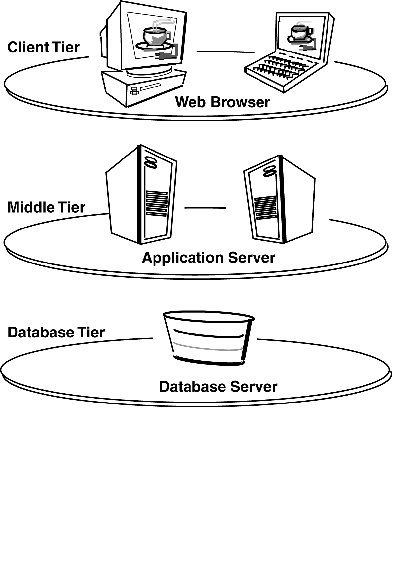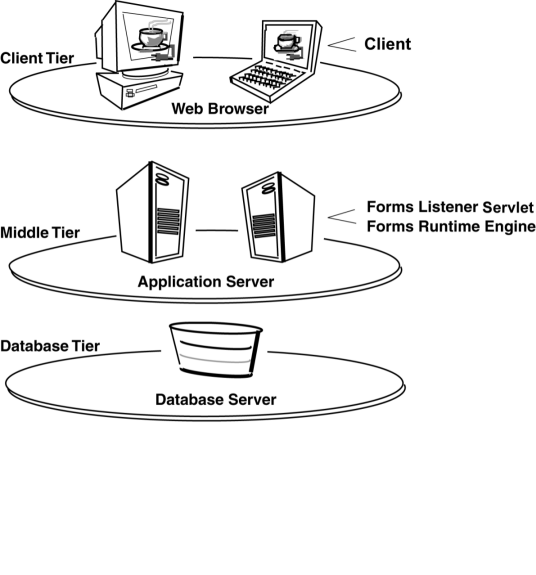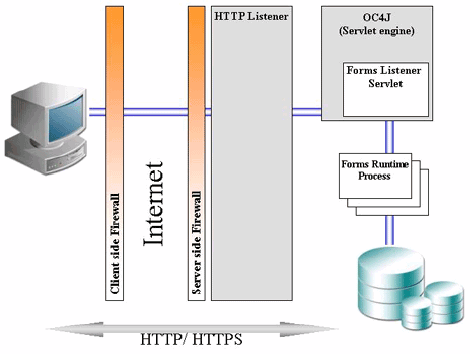10g (9.0.4)
Part Number B10470-01
Home |
Contents |
Index |
| Oracle Application Server Forms Services Deployment Guide 10g (9.0.4) Part Number B10470-01 |
|
This guide is intended to provide information about deploying applications with Oracle Application Server Forms Services. When you choose to deploy applications to the Internet, there are many decisions to be made as to how you will go about it. This guide provides information about those decisions and offers suggestions and methods for configuring your system for Web deployment of your applications. For a description of each chapter in this guide see the Preface.
This chapter contains the following sections:
With Oracle9i database to manage data, Oracle Developer Suite (OracleDS) to build applications, and Oracle Application Server to run them, the Oracle Internet Platform is a complete solution for building any type of application and deploying it to the Web. These Oracle tools provide a scalable and highly available infrastructure that enables customers to easily accommodate growing user populations.
Oracle offers a simple, complete, and integrated Internet platform composed of three core products:
Oracle Application Server is a scalable, secure, middle-tier aplication server. It enables you to deliver Web content, host Web applications, and connect to to back-office applications. Forms Services are an integral part of the Oracle Application Server bundle, which provides the technology to fully realize the benefits of Internet computing.
OracleDS combines the power of Oracle Application Development tools, Oracle Business Intelligence tools, the award-winning Oracle XML Developer Kit (XDK) and the Oracle Application Server Portal Developer Kit (PDK) in one product.
OracleDS is based on Internet standards including J2EE, XML, SOAP, UDDI, and UML, and provides a highly productive environment to build applications for Oracle Application Server and the Oracle9i Database Server.
Oracle9i Database Server is the latest generation of the world's most popular RDBMS. Among the numerous new capabilities are unlimited scalability and industry-leading reliability with Oracle9i Real Application Clusters; new high availability technology including advancements in standby database technology (Oracle Data Guard); and built-in OLAP, data mining and ETL functions.
Oracle Application Server is the best application server for the Oracle9i Database Server and applications built with Oracle development tools. By leveraging a common technology stack, Oracle Application Server can transparently scale an Oracle9i Database Server by caching data and application logic on the middle tier.
As part of Oracle Application Server, Oracle Application Server Forms Services is a new generation of tools that enable you to deploy new and existing Forms Services applications on the World Wide Web.
Forms Services is a comprehensive application framework optimized to deploy Forms applications in a multi-tiered environment. It takes advantage of the ease and accessibility of the Web and elevates it from a static information-publishing mechanism to an environment capable of supporting complex applications.
Much of the functionality that was handled by the Web server in Forms 6i has been assumed by components that are delivered with Oracle Application Server. For example, load balancing, security, scalability, HTTP/S communication handling, and deployment of Java servlets are all performed by various components delivered with OracleAS, such as the Oracle HTTP Server and Oracle Application Server Containers for J2EE (OC4J).
The Forms Services component of OracleAS handles all processing that is specific to Forms Developer applications, such as running the business logic defined in the Forms Developer application and providing the connection to the Oracle9i Database Server. A Java applet provides the client user interface.
New features for Forms Services include:
Forms Services use a three-tier architecture to deploy database applications. Figure 1-1 shows the three tiers that make up the Forms Services architecture:

Oracle Application Server Forms Services is a middle-tier application framework for deploying complex, transactional forms applications to the Internet. Developers can build new applications with Forms Developer and deploy them to the Internet with Forms Services. Developers can also take current applications that were previously deployed in client/server and move them to a three-tier architecture without changing the application code.
OracleAS Forms Services consists of three major components, as shown in Figure 1-2:

The Forms Listener Servlet acts as a broker between the Java client and the Forms runtime process. It takes connection requests from Java client processes and initiates a Forms runtime process on their behalf.
The Forms runtime process manages application logic and processing. It maintains a connection to the database on behalf of the Java client. It uses the same forms, menus, and library files that were used for running in client/server mode.
The Forms runtime process plays two roles: when it communicates with the client browser, it acts as a server by managing requests from client browsers and it sends metadata to the client to describe the user interface; when it is communicating with the database server, it acts as a client by querying the database server for requested data.
OracleAS Forms Services uses the Forms Listener Servlet (a Java servlet) to start, stop, and communicate with the Forms runtime process. The Forms runtime is what executes the code contained in a particular Forms application. The Forms Listener Servlet manages the creation of a Forms runtime process for each client and manages the network communications between the client and its associated Forms runtime process. The Forms Listener Servlet replaces the Forms Listener provided in previous releases of Oracle Forms.
|
Note: You do not need to configure the Forms Listener Servlet as it is already set up for you in the OracleAS installation process. |
Figure 1-3 illustrates how the client sends HTTP requests and receives HTTP responses from the Forms Server process. The HTTP Listener acts as the network endpoint for the client, keeping the other server machines and ports from being exposed at the firewall.

|
|
 Copyright © 2003 Oracle Corporation. All Rights Reserved. |
|